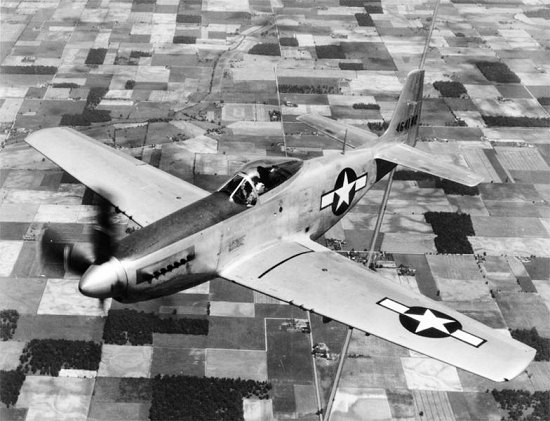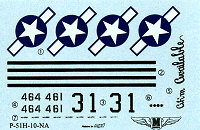
| KIT: | M News 1/72 P-51H Mustang |
| KIT #: | MN 72005 |
| PRICE: | $14.00 MSRP |
| DECALS: | One option |
| REVIEWER: | Scott Van Aken |
| NOTES: | Olde tyme short run with injected canopy |

| HISTORY |
The P-51H (NA-126) was the final production Mustang, embodying the experience gained in the development of the XP-51F and XP-51G aircraft. This aircraft, with minor differences as the NA-129, came too late to participate in World War II, but it brought the development of the Mustang to a peak as one of the fastest production piston engine fighters to see service.
The P-51H used the new V-1650-9 engine, a version of the Merlin that included Simmons automatic supercharger boost control with water injection, allowing War Emergency Power as high as 2218 hp (1,500 kW). Differences between the P-51D included lengthening the fuselage and increasing the height of the tailfin, which greatly reduced the tendency to yaw. The canopy resembled the P-51D style, over a somewhat raised pilot's position. Service access to the guns and ammunition was also improved. With the new airframe several hundred pounds lighter, the extra power and a more streamlined radiator, the P-51H was among the fastest propeller fighters ever, able to reach 487 mph (784 km/h or Mach 0.74) at 25,000 ft (7,600 m).
The P-51H was designed to complement the P-47N as the primary aircraft for the invasion of Japan with 2,000 ordered to be manufactured at Inglewood. Production was just ramping up with 555 delivered when the war ended. Production serial numbers:
Additional orders, already on the books, were cancelled. With the cutback in production, the variants of the P-51H with different versions of the Merlin engine were produced in either limited numbers or terminated. These included the P-51L, similar to the P-51H but utilizing the 2270 horsepower V-1650-11 Merlin engine, which was never built; and its Dallas-built version, the P-51M or NA-124 which utilized the V-1650-9A Merlin engine lacking water injection and therefore rated for lower maximum power, of which one was built out of the original 1629 ordered, serial number 45-11743.
Although some P-51Hs were issued to operational units, none saw combat in World War II, and in postwar service, most were issued to reserve units. One aircraft was provided to the RAF for testing and evaluation. Serial number 44-64192 was designated BuNo 09064 and used by the US Navy to test transonic airfoil designs, then returned to the Air National Guard in 1952. The P-51H was not used for combat in the Korean War despite its improved handling characteristics, since the P-51D was available in much larger numbers and was a proven commodity.
Many of the aerodynamic advances of the P-51 (including the laminar flow wing) were carried over to North American's next generation of jet-powered fighters, the Navy FJ Fury and Air Force F-86 Sabre. The wings, empennage and canopy of the first straight-winged variant of the Fury (the FJ-1) and the unbuilt preliminary prototypes of the P-86/F-86 strongly resembled those of the Mustang before the aircraft were modified with swept-wing designs.
| THE KIT |
 I'm not exactly sure just when this kit was originally produced as there is no date on the box or instructions, however, it has to be at least ten years ago. This is pretty much a standard "early era" type of Czech short run kit. It has all the hallmarks; lightly engraved panel lines, soft detail and the usual molding glitches of ejector pin towers, flash, and sink areas. While most of the towers will be relatively easy to erase, some, such as the one in the seat, will not. I also found sink areas on the prop blades and one of the main wheels looks like it was molded with a flat spot, but it is just a poor molding. All the parts have flash to some extent with the finer detailed parts being the ones
I'm not exactly sure just when this kit was originally produced as there is no date on the box or instructions, however, it has to be at least ten years ago. This is pretty much a standard "early era" type of Czech short run kit. It has all the hallmarks; lightly engraved panel lines, soft detail and the usual molding glitches of ejector pin towers, flash, and sink areas. While most of the towers will be relatively easy to erase, some, such as the one in the seat, will not. I also found sink areas on the prop blades and one of the main wheels looks like it was molded with a flat spot, but it is just a poor molding. All the parts have flash to some extent with the finer detailed parts being the ones most difficult to clean up.
most difficult to clean up.
There are no enclosed main wheel wells with the large inner gear doors molded in the 'up' position. The cockpit consists of a floor, seat, stick and instrument panel. There is some inner fuselage detail, however. The lower scoop has no outer face to smooth things out so your modeling skills will be needed there. As mentioned, the prop blades (all separate) are not well molded and need work to get to looking good. I also think the spinner may be a bit too short and pointy. The tailplanes seem improperly molded as they have a straight leading edge and don't match the instructions or the decal placement three-view. Wing tips also seem too rounded in this regard and the fuselage does not seem deep enough when comparing it to the box art. I should also mention that the machine gun openings are just holes in the leading edge of the wing. Can opy is fair as these things go, but again, just doesn't seem to be quite right.
opy is fair as these things go, but again, just doesn't seem to be quite right.
There are markings for one aircraft, the box art P-51H-10 from the 62nd FS/56 FG based in Alaska during 1946. The sheet looks to be well done and is quite matte. Those wishing different markings will have to rummage through the spares bin for them. Instructions are nicely drawn and I only wish the actual plastic was as well done as the drawings!
| CONCLUSIONS |
Well, it certainly looks like a P-51H despite all the things I said about it. Only the building and final conclusion will tell. For one thing, aside from the even more basic Beechnut kit, one a bit more well done by High Planes and the Wings 72 vac kit, this is probably one of the more easily obtained 1/72 H model Mustangs.
| REFERENCES |
November 2007 Thanks to 'store credit' for this one. If you would like your product reviewed fairly and fairly quickly, please contact the editor or see other details in the Note to Contributors.